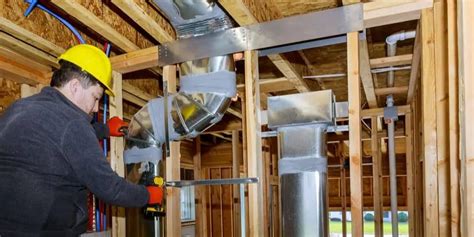How To Run Ductwork Between Floors
Ronan Farrow
Apr 02, 2025 · 3 min read

Table of Contents
How to Run Ductwork Between Floors: A Comprehensive Guide
Running ductwork between floors is a crucial part of any HVAC system installation. It allows for efficient air distribution throughout your home, ensuring comfortable temperatures in every room. However, it's a task that requires careful planning and execution. This comprehensive guide will walk you through the process, helping you navigate the complexities and achieve a successful installation.
Planning Your Ductwork Route: The Foundation of Success
Before you even think about grabbing your tools, meticulous planning is paramount. A well-planned route minimizes material waste, maximizes airflow efficiency, and reduces the potential for problems during installation.
1. Assess Your Floor Plan:
- Identify your HVAC unit's location: This dictates the starting point of your ductwork.
- Determine the location of your registers and returns: These are the endpoints, dictating where the air needs to go.
- Consider obstructions: Walls, beams, plumbing, and electrical wiring will all influence your route. Careful consideration of these factors prevents costly mistakes later.
- Sketch a detailed plan: Draw a diagram illustrating the proposed ductwork path, noting all obstructions and measurements. This will serve as your blueprint.
2. Choosing the Right Materials:
The material you choose directly impacts the performance and longevity of your ductwork. Common options include:
- Flexible ductwork: Easier to install, especially in tight spaces, but may be less efficient due to increased friction.
- Rigid metal ductwork: More efficient and durable, but requires more precision and skill during installation. This is generally preferred for optimal airflow.
3. Calculating Duct Size:
Improper sizing leads to inadequate airflow and inefficient heating/cooling. Using a professional HVAC calculator is recommended to ensure proper sizing based on your system's capacity and the distances involved.
Installation: A Step-by-Step Guide
Once your planning is complete, you can begin the installation process. Remember, safety should always be your top priority. If you lack experience, consider hiring a professional HVAC technician.
1. Cutting Access Holes:
Carefully cut access holes in your floor and ceiling joists to accommodate the ductwork. Ensure these holes are appropriately sized to avoid compromising the structural integrity of your floors.
2. Securing the Ductwork:
Use appropriate fasteners to securely attach the ductwork to the joists and framing. This prevents sagging and ensures efficient airflow. Proper support is crucial, especially over longer spans.
3. Insulating the Ductwork:
Insulating your ductwork minimizes heat loss or gain, improving the efficiency of your HVAC system and reducing energy costs. This is particularly important in attics or unconditioned spaces.
4. Connecting the Ducts:
Use appropriate connectors and sealant to create airtight connections between duct sections. Leaks will severely reduce the efficiency of your system. Ensure all seals are tight and properly secured.
5. Testing for Leaks:
After installation, test for leaks using a blower door or other appropriate testing method. This identifies any issues that need to be addressed before closing up the access holes.
Finishing Touches and Final Considerations
1. Restore Access Holes:
After ensuring everything is functioning correctly, neatly repair the access holes with appropriate patching materials.
2. Professional Installation:
While this guide provides a comprehensive overview, tackling this project yourself can be challenging and even risky. If you're uncomfortable with any aspect of the installation, it's always best to consult a qualified HVAC professional. They possess the expertise and experience to ensure a safe and efficient installation.
By carefully following these steps and prioritizing safety, you can successfully run ductwork between floors, enhancing the efficiency and comfort of your home's HVAC system. Remember, proper planning is key to a successful project.
Featured Posts
Also read the following articles
| Article Title | Date |
|---|---|
| How To Take Ac Out Of Window | Apr 02, 2025 |
| How To Transport A Paddle Board | Apr 02, 2025 |
| How To Recharge Rv Ac Unit | Apr 02, 2025 |
| How To Refurbish Aluminum Wheels | Apr 02, 2025 |
| How To Train Your Dragon Helmet | Apr 02, 2025 |
Latest Posts
-
Invisalign Refinements How Many
Apr 03, 2025
-
Invisalign How Many Refinements
Apr 03, 2025
-
If I M Shooting High How Do I Adjust My Scope
Apr 03, 2025
-
Howe Center Rutland Vt
Apr 03, 2025
-
Howa Super Lite Review
Apr 03, 2025
Thank you for visiting our website which covers about How To Run Ductwork Between Floors . We hope the information provided has been useful to you. Feel free to contact us if you have any questions or need further assistance. See you next time and don't miss to bookmark.
